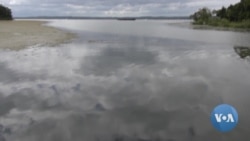More than 200 wooden ships, scuttled from the 1700s to the 1900s, are laid to rest in a watery grave in Mallows Bay near Nanjemoy, Maryland, forming the newest national marine sanctuary in the United States and the first to protect partially submerged vessels. Their skeletal remains rise like an apparition out of the water.
“When the tide goes out, the ships come up, and so they’ve been called the ghost fleet,” explains Joel Dunn, president of the Chesapeake Conservancy environmental group.
Located on the Potomac River, 60 kilometers south of Washington, a rusty steel-hull ferry abandoned in the 1970s appears in the distance from shore. But the best way to view the ships is by kayak, especially to see the stars of the show: 100 American World War I cargo vessels hastily and shoddily built about a century ago.
“These large wooden steam ships (about 80 meters long) were built for a variety of purposes, including shipping overseas equipment to Europe during World War I,” Dunn says as he paddles near a vessel that was used to carry timber logs. “The only problem was that most of them were finished after the war, so they were brought to Mallows Bay and sold to a salvage company.”
Obsolete ships sunk
A few years after the war ended in 1918, the obsolete ships were stripped of their metal, broken down, burned and sunk in the relatively shallow waters of the small bay.
Today, floating, decaying wood, some that sticks up like tree trunks, and large iron nails, provide a kind of obstacle course for kayakers in the murky waters.
Dunn points out a big square stone on top of a piece of wood.
“These stones were originally in the bottom, in the hull of the ship, and they balanced the ship.”
Good for wildlife, environment
Today, they serve as a manmade wildlife sanctuary for fish, beavers and raptors like bald eagles and ospreys. Vegetation is also growing around the wood that looks like floating water pots.
“It’s tremendous for the environment because they’re actually cleaning the water, providing habitat, and helping with climate change,” says Susan Langley, Maryland state underwater archeologist.
The gradually rotting wood in the brackish water does not harm the environment.
“Because it’s underwater it doesn’t receive as much oxygen, and so the decay is a lot slower,” Dunn explains. “There’s also salt water, which further reduces the decay.”
The underwater park contains the largest number of shipwrecks in the Western Hemisphere. And although dead in the water, the world’s biggest collection of World War I ships.
“This is the only place where you can see the size of these vessels and the cross-section of different designs,” Langley says. “It is like one big museum.”






